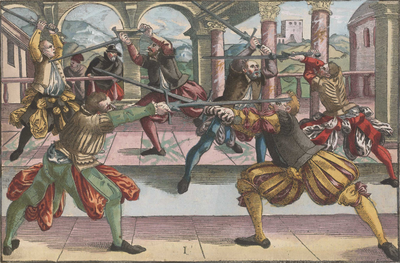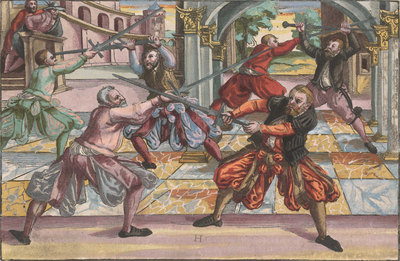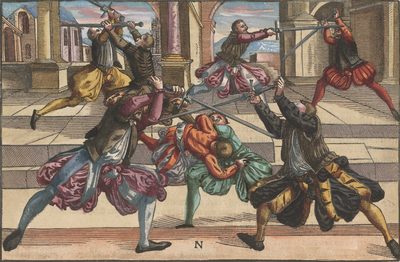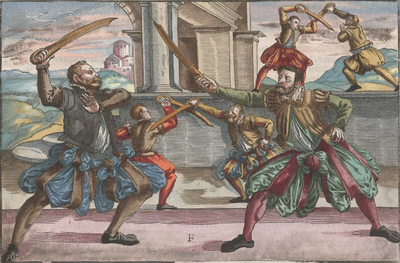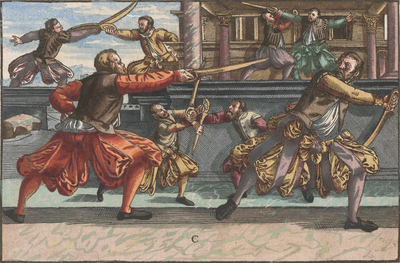|
|
You are not currently logged in. Are you accessing the unsecure (http) portal? Click here to switch to the secure portal. |
Difference between revisions of "Rosen"
Jump to navigation
Jump to search
| Line 87: | Line 87: | ||
<p>If you find an opponent waiting in the Bow, then act as if you intended to cut from above at his head; do not let the cut connect, but go outside his right arm and through below, so that you come around in a circle around his dusack, and let it run off again in the air beside his right, and cut at his face. You may go around his parrying this way on the other side in a circle, and cut in where you find him open.</p> | <p>If you find an opponent waiting in the Bow, then act as if you intended to cut from above at his head; do not let the cut connect, but go outside his right arm and through below, so that you come around in a circle around his dusack, and let it run off again in the air beside his right, and cut at his face. You may go around his parrying this way on the other side in a circle, and cut in where you find him open.</p> | ||
| {{section|Page:Gründtliche Beschreibung der Kunst des Fechtens (Joachim Meÿer) 1570.pdf/172|3|lbl=2.11ra}} | | {{section|Page:Gründtliche Beschreibung der Kunst des Fechtens (Joachim Meÿer) 1570.pdf/172|3|lbl=2.11ra}} | ||
| + | |||
| + | |||
| + | |- | ||
| + | | [[File:Meyer 1570 Messer F.jpg|center|400px]] | ||
| + | | <p>'''The Straight Parrying or Slice'''</p> | ||
| + | |||
| + | <p>Chapter 11</p> | ||
| + | |||
| + | <p>In this parrying, position yourself thus: stand with your right foot forward and hold your dusack in front of you with your arm extended, so that your long edge stands toward the opponent and the tip of your weapon is forward, as shown by the large figure on the right in the adjoining image. I consider this posture the best of all, because you can wait for your opponent in this position more safely than in any other.</p> | ||
| + | | {{section|Page:Gründtliche Beschreibung der Kunst des Fechtens (Joachim Meÿer) 1570.pdf/215|2|lbl=2.32v}} | ||
| + | |||
| + | |- | ||
| + | | | ||
| + | | <p>'''A Swift Deceitful Device to execute against this Straight Parrying '''</p> | ||
| + | |||
| + | <p>Note when you find your opponent in Straight Parrying, then position yourself in the Onset in the Wrath Guard or Steer, and send a high stroke with earnest comportment from your right shoulder at his face. Yet do not let it hit, but just as the cut should connect above, go below with your dusack and toward his left right around his dusack in a circle through the Rose, so that your dusack comes under his right arm and out toward your<ref>read: his?</ref> left up in the air. Then quickly let it run off twice in the air, once against his left, the second time against his right, and deliver a Middle Cut through from your right at his face. For all this you shall have two steps forward, the one for the first Wrath Cut, with which you will not hit but go around beside him without hitting, the second for the double running off and the Middle Cut; for when you bring your dusack in the air for the running off, you shall at the same time lift up your right foot, and execute the double running off so quickly that you hit with the Middle Cut just as you set your foot back down again.</p> | ||
| + | | {{section|Page:Gründtliche Beschreibung der Kunst des Fechtens (Joachim Meÿer) 1570.pdf/220|3|lbl=2.35r}} | ||
| + | |||
| + | |- | ||
| + | | | ||
| + | | <p>This is a fluid and swift device and proceeds well, if you first learn to do it well. As soon as the Horizontal Cut has hit, then strike back across from below to his right arm with good parrying. When you hit with this cut, then note whether he is high or low with his arm: if he is high, then turn your point under his arm with a thrust at his chest or hip; but if he is low, then turn your point above his arm at his face, palm away from him, so that your long edge stands upward in the thrust. One of these two thrusts will be most suitable for you, either palm toward or away from him. Then follow up this thrust powerfully and quickly with a cut, namely the High Thrust with a Low Cut through his right, the Low Thrust with a High Cut through his left.</p> | ||
| + | | {{section|Page:Gründtliche Beschreibung der Kunst des Fechtens (Joachim Meÿer) 1570.pdf/220|4|lbl=-|p=1}} {{section|Page:Gründtliche Beschreibung der Kunst des Fechtens (Joachim Meÿer) 1570.pdf/221|1|lbl=2.35v|p=1}} | ||
| + | |||
| + | |- | ||
| + | | [[File:Meyer 1570 Messer C.jpg|center|400px]] | ||
| + | | <p>'''Concerning the Middle Guard and How One''' Shall Fight from It</p> | ||
| + | |||
| + | <p>Chapter 14</p> | ||
| + | |||
| + | <p>I call this the Middle Guard because it arises from the Middle Cut. Now you can come into this guard at the end of three cuts: first when you strike a Crooked Cut from your right through the Wrath Line, and let it swing beside your left right back into the Middle Guard; then through the Middle Cut itself; thirdly when you strike a Crooked Cut from below through the upward diagonal line from your right toward your left. These three cuts always swing most readily to the Middle Guard, even if you try to pull them to another.</p> | ||
| + | | {{section|Page:Gründtliche Beschreibung der Kunst des Fechtens (Joachim Meÿer) 1570.pdf/236|2|lbl=2.43r}} | ||
| + | |||
| + | |- | ||
| + | | | ||
| + | | <p>Position yourself for it as shown by the figure on the right in this image. From this guard you can execute all the devices that are taught in the left Wrath and Steer; therefore I will only briefly recount a few devices, from which you will sufficiently learn the use of this guard.</p> | ||
| + | | {{section|Page:Gründtliche Beschreibung der Kunst des Fechtens (Joachim Meÿer) 1570.pdf/236|3|lbl=-}} | ||
| + | |||
| + | |- | ||
| + | | | ||
| + | | <p>'''How you shall flick from this guard outside at his right arm'''<br/><br/></p> | ||
| + | |||
| + | <p>Another: if an opponent encounters you in the Bow or in Straight Parrying, then position yourself in the Middle Guard; from there strike outside at his right arm with the outside flat in a flick. Quickly pull your hilt up, so that in this pulling up, your blade hangs down, and with this, jerk your dusack around your head. Then cut through with the crooked edge from below inside at his right arm with a step forward on your right foot, so that at the end of the cut your dusack comes [2.45v] into the left Wrath Guard. From there cut powerfully from below through his face; then quickly cut after with the Cross.</p> | ||
| + | |||
| + | <p>Also you can attack from this guard using the Rose, with Flicking Cuts and other deceits. For the Rose Cuts go particularly well with a deceit from this Middle Guard, thus:</p> | ||
| + | |||
| + | <p>If you find an opponent in the Bow who is smaller than you, then send your outside flat from your right above his hilt toward his right, outside his right arm, and in a single motion under his dusack back up toward your right. Let it fly back around above your head in the air, with your foot raised, and strike him with hanging dusack and inside flat in a flick outside to his right arm. Then pull upward, and cut the Roarer across through the Middle Line, as you have learned previously in the section on the cuts. And this must take place in a single motion, so that in the beginning of the motion you lift your right foot, and as the Roarer hits, you set it back down with a step forward.</p> | ||
| + | | | ||
| + | {{section|Page:Gründtliche Beschreibung der Kunst des Fechtens (Joachim Meÿer) 1570.pdf/240|4|lbl=2.45r|p=1}} {{section|Page:Gründtliche Beschreibung der Kunst des Fechtens (Joachim Meÿer) 1570.pdf/241|1|lbl=2.45v|p=1}} | ||
| + | |||
| + | |} | ||
| + | {{master subsection end}} | ||
| + | |||
| + | {{master subsection begin | ||
| + | | title = Rapier | ||
| + | | width = 90em | ||
| + | }} | ||
| + | {| class="floated master" | ||
| + | |- | ||
| + | ! <p>Images</p> | ||
| + | ! <p>{{rating|C|Draft Translation (from the 1570)}}<br/>by [[Mike Rasmusson]]</p> | ||
| + | ! <p>[[Gründtliche Beschreibung der Kunst des Fechtens (Joachim Meyer)|1570 Transcription]]{{edit index|Gründtliche Beschreibung der Kunst des Fechtens (Joachim Meÿer) 1570.pdf}}</p> | ||
| + | |||
| + | |- | ||
| + | | | ||
| + | | | ||
| + | | | ||
| + | |||
| + | |- | ||
| + | | | ||
| + | | | ||
| + | | | ||
| + | |||
| + | |- | ||
| + | | | ||
| + | | | ||
| + | | | ||
| + | |||
| + | |- | ||
| + | | | ||
| + | | | ||
| + | | | ||
| + | |||
| + | |- | ||
| + | | | ||
| + | | | ||
| + | | | ||
| + | |||
| + | |- | ||
| + | | | ||
| + | | | ||
| + | | | ||
| + | |||
| + | |- | ||
| + | | | ||
| + | | | ||
| + | | | ||
|} | |} | ||
Revision as of 20:57, 12 November 2018
- ↑ read: his?

